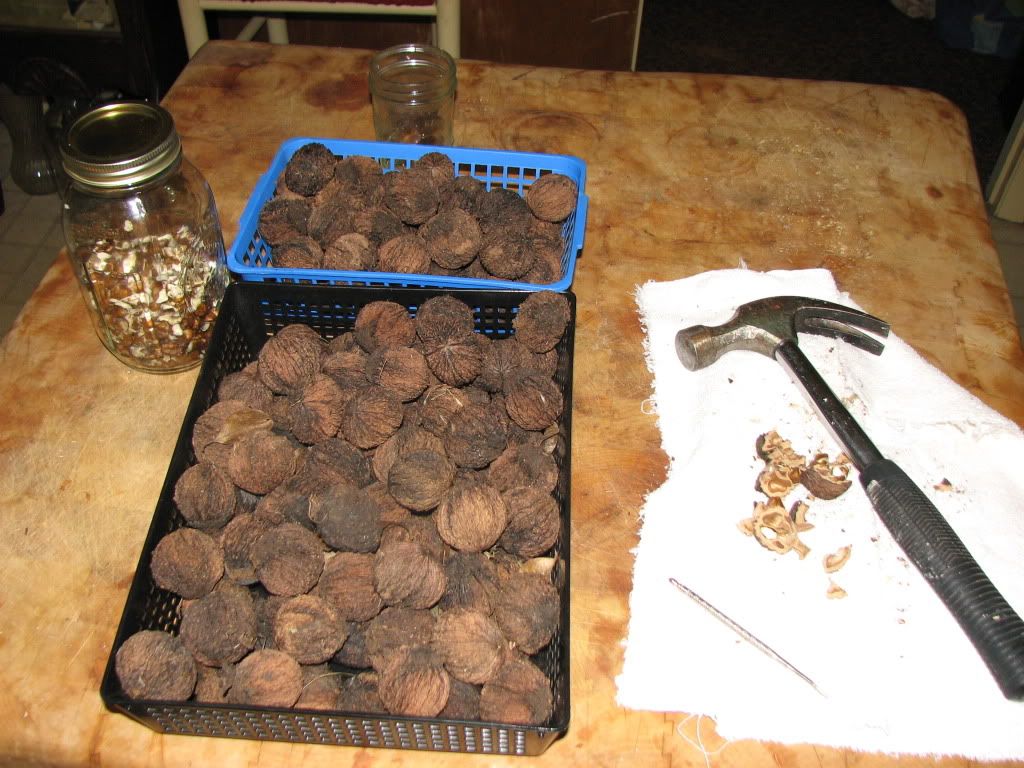How to Find and Enjoy Black Walnuts
You may have noticed a tree in your neighborhood that rains dull green baseballs each fall.
In most locations these heavy fruits are ignored by residents, unless a group of children utilizes them in a mock battle – or better yet – discovers the joys of walnut-stained body parts and clothing. Often my mother threw up her hands in despair when faced on Sunday morning by artificially “tanned” children. At least my sister and I wouldn’t suffer from UV damage, but it certainly wasn’t coming off before church.

Photo Caption: Rinsing black walnuts after the baseball-sized hulls have been removed prevents their stain from seeping through the shell and darkening the nut meat within. The stain is attractive (perhaps not on the driveway) and can be used to dye fabric, paper, wood, and other items.
It’s a shame that black walnuts so rarely make it to the table. They have excellent culinary value and an often superior taste to the expensive nuts we purchase throughout the year. Their rich, slightly decadent flavor contains hints of dried fruit that shows up well in recipes.
They’re also largely ignored by squirrels until later in the season due to their fortress-like packaging. Squirrels will snack on white acorns and pecans until these thin-shelled treats run out. Anyone who has ever tried to race a squirrel to harvest will appreciate the ability to leisurely collect a full tree’s worth of nuts.
However, the nut’s sturdy defenses are the same reason they are rare in commercial production.
Finding available black walnuts is not challenging in this area. They’re native and have been a common homestead tree for generations. Neighbors will likely give you all that you can carry if you knock on the door to ask, but I also find the nuts scattered along roadside curbs or swept into a debris pile waiting to be carried off to a landfill. Craigslist is another place you can look – people offer them for free or for sale.
Getting through the green husks to the nut seems challenging until you realize that nature will do it for you (if you find husk fly larva, don’t worry – they won’t get inside the actual nut). Spread the nuts on the ground and keep an eye on them. Once they turn completely black but are still soft, the husks will slip off easily. A good rain will help if they’ve gotten dry and wrinkly. If you don’t want your hands stained, stomp on the nuts wearing old shoes or put them in the lawn and do some mowing. Once the outer husks are off you should rinse the hard shells to get the rest of the stain removed.
Note that the juglone in the husks can kill earthworms and some plants, though it is eventually destroyed during the composting process.
After the husks are removed some people dry the unshelled nuts in the sun for about 4 weeks to cure them. However, we started eating ours right away. If you do decide sun-bathing is necessary, keep in mind that husk-free nuts are more tempting to squirrels. (As far as I can tell, the biggest reason to “cure” them is to get the moisture out of the shells so that unshelled nuts won’t mold in storage).

Photo Caption: Harder to crack than the light tan walnuts found at the grocery, black walnuts make the effort worthwhile with their vibrant flavor.
Black walnut shells will defy most of the cute holiday nut crackers available. I’ve read lots of recommended nut shelling methods, including backing over them with your car and squeezing them in a vice. I think the vice method probably works best if you want to remove undamaged whole meats from the shells, but for sheer ease and tool availability we’ve just been using a hammer on nuts wrapped in a rag. The rag prevents bits of shell from exploding all over the kitchen.
Our kitchen is equipped with a stout, restaurant-quality butcher block. Hammering nuts on your nice marble or wood-finished countertops is not a great idea, so if you don’t have something sturdier, find some outdoor concrete to use.
Once shelled, nuts can be frozen in batches to prevent them from going rancid until you use them.
Recipe time! My mom has been making a lovely breakfast cake out of our walnuts (that I’ve been munching as I write this blog entry). Here’s how to make it:
Black Walnut Applesauce Cake
- 1/2 cup unsalted butter or margarine
- 3/4 cup packed brown sugar
- 1 egg
- 1 cup all purpose flour
- 1 cup white whole wheat flour (or regular whole wheat flour)
- 2 tsp baking powder
- 1 tsp baking soda
- 1 tsp ground cinnamon
- 1 & 3/4 cups unsweetened applesauce (we use homemade)
- 1 cup chopped black walnuts
In a large mixing bowl cream butter/margarine with sugar and egg, beat until combined. Stir together flour, baking powder, baking soda, and cinnamon. Add flour mixture alternately with applesauce to the butter mixture and stir. Stir in nuts. Pour batter into a greased 13 x 9″ baking pan and spread evenly. Bake at 350 F for 30 – 35 minutes, or until a wooden pick inserted near the center comes out clean.
3 thoughts on “How to Find and Enjoy Black Walnuts”
Comments are closed.

Sandra - January 26, 2010 3:15 pm
Good article, informatiave
Sandra - January 26, 2010 3:17 pm
Ah, sorry. Had a little help from Sam; seems he wants me to leave the computer.
Good article, informative and useful information. I use walnut hulls to dye my wool, makes a beautiful fleece, yarn or roving. One thing, tomatoes and walnuts don’t get along; walnuts tend to kill the tomatoes.
Pingback: How to Forage in the City | Appalachian Feet